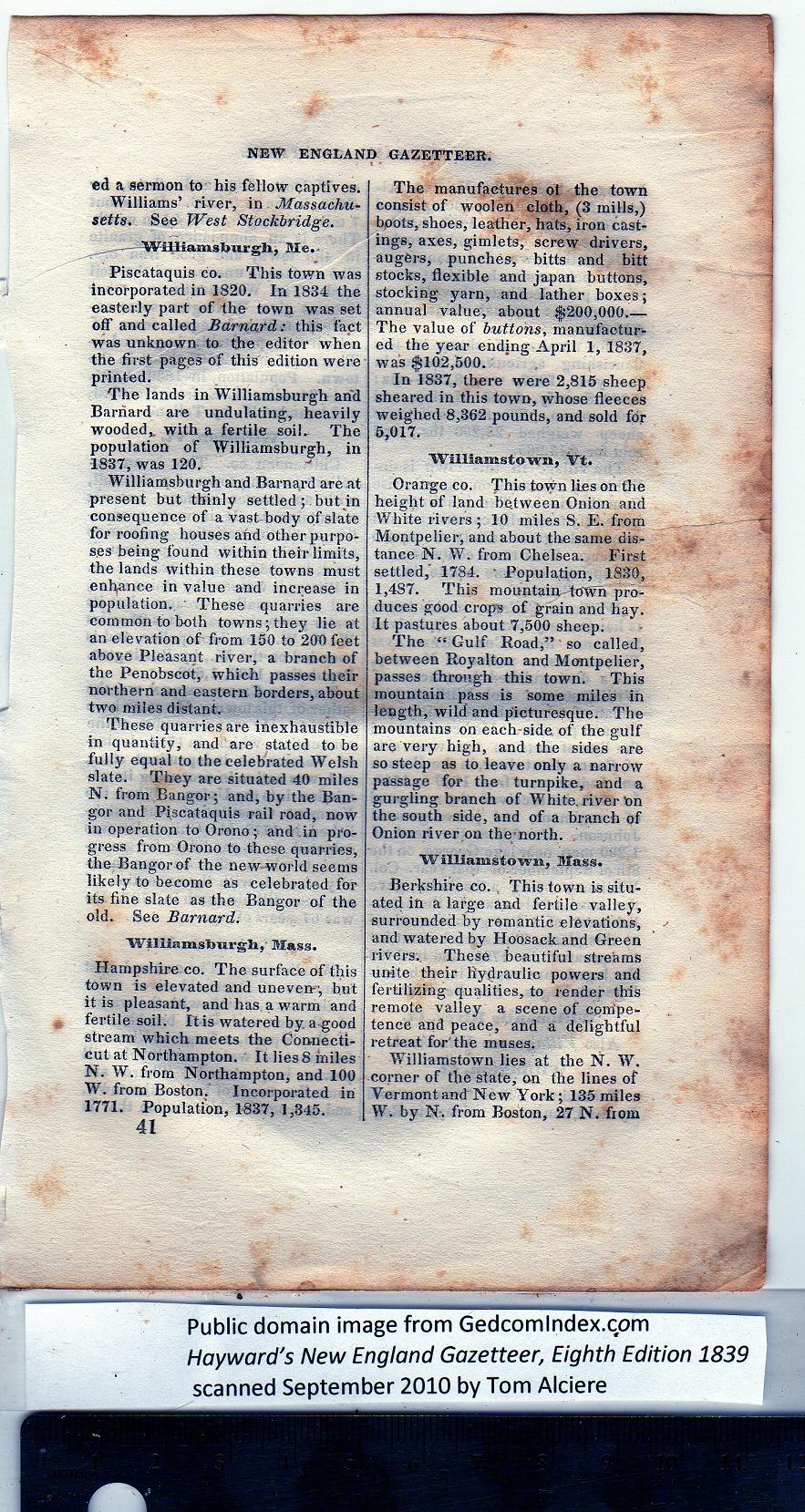|
ed a sermon to his fellow captives.
Williams’ river, in .Massachu-
setts. See West Stockbridge.
Williamsburglx, Me.
Piscataquis co. This town was
incorporated in 1820. In 1834 the
easterly part of the town was set
off and called Barnard: this fact
was unknown to the editor when
the first pages of this edition were
printed.
The lands in Williamsburgh and
Barnard are undulating, heavily
wooded,, with a fertile soil. The
population of Williamsburgh, in
1837, was 120.
Williamsburgh and Barnard are at
present but thinly settled; but in
consequence of a vast body of slate
for roofing houses and other purpo-
ses being found within their limits,
the lands within these towns must
enhance in value and increase in
population. ' These quarries are
common to both towns; they lie at
an elevation of from 150 to 200 feet
above Pleasant river, a branch of
the Penobscot, which passes their
northern and eastern borders, about
two miles distant.
These quarries are inexhaustible
in quantity, and are stated to be
fully equal to the celebrated Welsh
slate. They are situated 40 miles
N. from Bangor; and, by the Ban-
gor and Piscataquis rail road, now
in operation to Orono; and in pro-
gress from Orono to these quarries,
the Bangor of the new-world seems
likely to become as celebrated for
its fine slate as the Bangor of the
old. See Barnard.
Williamsburgb, Mass.
Hampshire co. The surface of this
town is elevated and uneven-; but
it is pleasant, and has a warm and
fertile soil. It is watered by a good
stream which meets the Connecti-
cut at Northampton. It lies 8 miles
N. W. from Northampton, and 100
W. from Boston. Incorporated in
1771. Population, 1837, 1,345.
41 |
The manufactures ot the town
consist of woolen cloth, (3 mills,)
boots, shoes, leather, hats, iron cast-
ings, axes, gimlets, screw drivers,
augers, punches, bitts and bitt
stocks, flexible and japan buttons,
stocking yarn, and lather boxes;
annual value, about $200,000.—
The value of buttons, manufactur-
ed the year ending April 1, 1837,
was $102,500.
In 1837, there were 2,815 sheep
sheared in this town, whose fleeces
weighed 8,362 pounds, and sold for
5,017.
Williamstown, Vt.
Orange co. This town lies on the
height of land between Onion and
White rivers ; 10 miles S. E. from
Montpelier, and about the same dis-
tance N. W. from Chelsea. First
settled,' 1784. ' Population, 1S30,
1,487. This mountain town pro-
duces good crops of grain and hay.
It pastures about 7,500 sheep.
The “Gulf Road,” so called,
between Royalton and Montpelier,
passes through this town. This
mountain pass is some miles in
length, wild and picturesque. The
mountains on each-side of the gulf
are very high, and the sides are
so steep as to leave only a narrow
passage for the turnpike, and a
gurgling branch of White, river On
the south side, and of a branch of
Onion river on the/north.
Williamstown, Mass.
Berkshire co. . This town is situ-
ated in a large and fertile valley,
surrounded by romantic elevations,
and watered by Hoosack and Green
rivers. These beautiful streams
unite their hydraulic powers and
fertilizing qualities, to render this
remote valley a scene of compe-
tence and peace, and a delightful
retreat for the muses.
Williamstown lies at the N. W.
corner of tbe state, on the lines of
Vermont and New York; 135 miles
W. by N. from Boston, 27 N. from |
